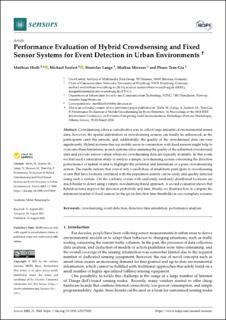| dc.contributor.author | Hirth, Matthias | |
| dc.contributor.author | Seufert, Michael | |
| dc.contributor.author | Lange, Stanislav | |
| dc.contributor.author | Meixner, Markus | |
| dc.contributor.author | Tran-Gia, Phuoc | |
| dc.date.accessioned | 2022-04-05T08:33:40Z | |
| dc.date.available | 2022-04-05T08:33:40Z | |
| dc.date.created | 2021-11-19T12:35:40Z | |
| dc.date.issued | 2021 | |
| dc.identifier.citation | Sensors. 2021, 21 (17), . | en_US |
| dc.identifier.issn | 1424-8220 | |
| dc.identifier.uri | https://hdl.handle.net/11250/2989826 | |
| dc.description.abstract | Crowdsensing offers a cost-effective way to collect large amounts of environmental sensor data; however, the spatial distribution of crowdsensing sensors can hardly be influenced, as the participants carry the sensors, and, additionally, the quality of the crowdsensed data can vary significantly. Hybrid systems that use mobile users in conjunction with fixed sensors might help to overcome these limitations, as such systems allow assessing the quality of the submitted crowdsensed data and provide sensor values where no crowdsensing data are typically available. In this work, we first used a simulation study to analyze a simple crowdsensing system concerning the detection performance of spatial events to highlight the potential and limitations of a pure crowdsourcing system. The results indicate that even if only a small share of inhabitants participate in crowdsensing, events that have locations correlated with the population density can be easily and quickly detected using such a system. On the contrary, events with uniformly randomly distributed locations are much harder to detect using a simple crowdsensing-based approach. A second evaluation shows that hybrid systems improve the detection probability and time. Finally, we illustrate how to compute the minimum number of fixed sensors for the given detection time thresholds in our exemplary scenario. | en_US |
| dc.language.iso | eng | en_US |
| dc.publisher | MDPI | en_US |
| dc.rights | Navngivelse 4.0 Internasjonal | * |
| dc.rights.uri | http://creativecommons.org/licenses/by/4.0/deed.no | * |
| dc.subject | crowdsensing; event detection; detection time simulation; performance analysis | en_US |
| dc.title | Performance evaluation of hybrid crowdsensing and fixed sensor systems for event detection in urban environments | en_US |
| dc.type | Journal article | en_US |
| dc.type | Peer reviewed | en_US |
| dc.description.version | publishedVersion | en_US |
| dc.source.pagenumber | 0 | en_US |
| dc.source.volume | 21 | en_US |
| dc.source.journal | Sensors | en_US |
| dc.source.issue | 17 | en_US |
| dc.identifier.doi | 10.3390/s21175880 | |
| dc.identifier.cristin | 1956437 | |
| cristin.ispublished | true | |
| cristin.fulltext | original | |
| cristin.qualitycode | 1 | |

